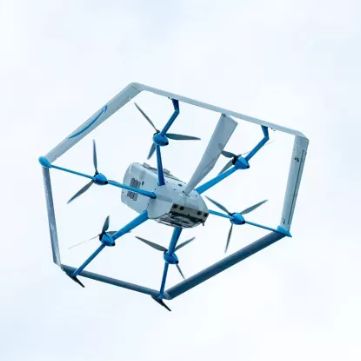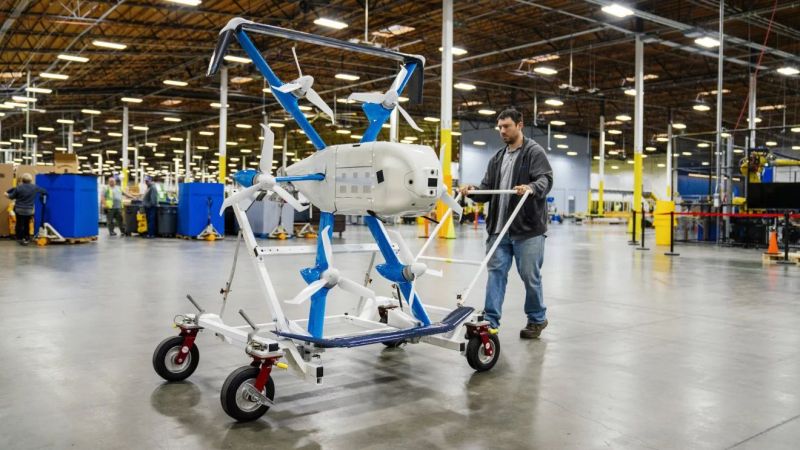
When Amazon started its Prime Air drone delivery service in 2022, it had picked College Station (Texas) and Lockeford (California) as its the first areas where the service would be offered. Two years later, Amazon has now announced that it will be expanding to the West Valley of the Phoenix Metro area in Arizona from a new Tolleson center, while casually mentioning buried in the press release that the Lockeford area will no longer be serviced. No reason for this closure was provided, but as a quite experimental service drastic shifts can be expected as Amazon figures out what does and does not work.
Amazon Prime Air features custom drones that can transport packages up to 5 lbs (~2.27 kg) to its destination within an hour, if the item is listed as Prime Air capable for your area. Along with the change in service areas, Amazon is also testing its new MK30 drone (pictured, top), which should be much quieter due to a new propeller design and have twice the range of the old MK27 as well.
Even if flying drone delivery isn’t quite a blow-away success yet, Amazon doesn’t seem to be letting up on investing in it, and it could be argued that for certain items like medication or perishables, it does make a certain sense over traditional delivery and pick-up methods.
















t’s interesting to see Amazon adjust their drone delivery strategy, shifting from California to Arizona. Their continuous investment in newer, quieter drones like the MK30 shows a strong commitment to enhancing this service. Although it hasn’t been a massive hit yet, focusing on delivering essentials like medications quickly could really prove the value of drone deliveries in the future.
It’s California probably left due to theft.
Exactly lol
I wasn’t even aware Amazon Air was still flying. I was very disappointed when the new FAA rules for hobby/model aviation came out requiring registration and remote ID, and at the time it seemed like the only reason the FAA was pushing those rules was because of delivery drone hype. So how is that working out for the delivery drone industry? How does Amazon get away with flying outside the line of sight of observers? Have wheeled delivery robots taken all the “wind out of their sails”?
The easily calculable infinitesimal chance of civilian hobby and professional drones creating any significant ACCIDENTAL hazard to manned aircraft or the, after any analysis, incredibly stupid dream of using drones for regular deliveries of consumer products over populated areas have NOTHING to do with the FAA regulations prohibiting individuals from flying a >250 gram RC aircraft 0.1mm over the grass (airborne) on their own property without registering THEMSELVES (NOT their aircraft as deceptively claimed by the FAA for a long time) with the FAA. That’s just the cover story.
Anyone with a few brain neurons could have, as I did, search online for the governments’ ACTUAL concerns about FPV RC aircraft in the years prior to the intentional hysteria they whipped up in a willing, technology stupid, sensationalist media with their 2015 Christmas Drone Apocalypse BS (which never happened, of course). Remember that? However, they even more clearly gave the real reason away when they, immediately after RC pilot registration had been put in place, shut down ALL RC flying within 30 MILES of Washington DC and ONLY Washington DC.
Get it, yet? No? OK. How are even small, cheap hobby drones being used in the the Ukraine/Russia conflict?
Here’s the ACTUAL threat to anything airborne:
FAA Report: Wildlife Strikes to Civil Aircraft in the United States 1990-2022
In 2022, 17,190 strikes were reported, an increase of 10 percent compared to the 15,639 strikes reported in 2021. The 10 percent increase was directly related to the respective 10 percent and 4 percent increases in aircraft movements at Part 139 airports (certificated for passenger service) and general aviation airports in 2022 compared to 2021 following relaxation of COVID-19 travel restrictions. For the 33-year period (1990–2022), 276,846 strikes were reported of which 272,016 (98.3 percent) occurred in the USA.
A negative effect-on-flight was reported in 5 percent and 15 percent of the bird and terrestrial mammal strike reports, respectively, 1990-2022. Precautionary/emergency landing after striking wildlife was the most reported negative effect (8,030 incidents), including 330 incidents in which the pilot either jettisoned fuel (63 incidents, mean of 14,421 gallons), made an overweight landing (135 incidents), or burned fuel in circling pattern (132 incidents). Aborted take-off was the second most reported negative effect (2,976 incidents). These negative incidents included 601 aborted take-offs at >100 knots. As has the trend for the percentage of strikes causing damage, the percentage of strikes with a reported negative effect-on-flight has declined from a high of 11 percent in 1995-1996 to 3 percent in 2022. For commercial transport aircraft, the number of high-speed (>100 knots) aborted take-offs declined from a high of 25 in 2000 to 8 in 2022.
Eighty-one strikes resulted in a destroyed aircraft from 1990-2022 (none in 2022); 46 (57 percent) of these occurred at general aviation airports. The annual cost of wildlife strikes to the USA civil aviation industry in 2022 was projected to be 67,848 hours of aircraft downtime and $385 million in direct and other monetary losses. These projections may be at the high end of actual costs because of the skewed nature of reported cost data. More thorough reporting of strike events and associated costs combined with additional economic analyses are needed to refine the actual costs of wildlife strikes to the aviation industry.
There’s no wonder WHY Amazon would pull out of California for a potential drone delivery service. Litigation and crime and the lack of prosecution against criminals. A person could see the drone and fake a heart attack and sue Amazon for their UFO….or maybe Gangs of people will chase that drone and hammer it and steal the shipment. Lockeford, CA is between San Francisco & Sacramento….not quite the epicenter of evil; that might be Oakland, but it’s all close. I’m not going to get into politics, but even Jeff Bezos sees a losing venture when anarchy rules.
Or have a real heart attack seeing that thing coming at them.
No, no..that’s MKIII version, with gun turret and steel blades.
The usual anti-California crime rhetoric rings hollow. One, Lockeford is in the Central Valley, one of the most right-leaning regions in the Western US. A casual internet search shows that Tolleson has twice the population and three times the population density of Lockeford, not to mention the surrounding communities. Add to this Arizona being much more open to autonomous tech development while California is more heavily regulating. It’s an economic decision, but to blame it on crime or “urban” or whatever other anti-Californian-leftism is bunk.
Please stay there then
>Amazon is also testing its new MK30 drone (pictured, top), which should be much quieter due to a new propeller design and have twice the range of the old MK27 as well.
Ukraine would love few of those for testing.
Ukraine would love to abandon them on the battlefield.
FTFY
Boy we just don’t learn about leaving mountains of our war hardware in unstable countries do we? You’d think the lesson would eventually sink in
There’s a big difference between an unstable country such as Afghanistan, where there was a lot more internal power struggles, or Irak, where there was a dictatorship and no follow-up plans, or Ukraine, politically more stable internally, with their own democratic system that was functioning and stabilizing further, which then gets attacked by an expensionist state led by a dictator with a hunger for past glory. There’s apparently multiple lessons that still need sinking in rather broadly, not just on the part of others, but also on yours.
Real question: how many 555s in the previous drone, how many in the new one?
>with their own democratic system
They don’t even have elections anymore lol. Also we were being told about “democracy” in afghanistan and iraq for years, it’s the go-to propaganda line whenever we get involved in a war. The good guys are the democracy (regardless of whether they have votes or elections) and the bad guys are the evil dictators. Simple as that, right? Good guys always win.
Why not just do midnight delivery, 0 traffic.
In general, Northern California did something scummy: the made it nearly impossible for individuals to fly drones anywhere–while letting commercial entities fly them. I know of only 2 places in all Silicon Valley where a amateur could fly. The airspace is bad, the restrictions are far worse.